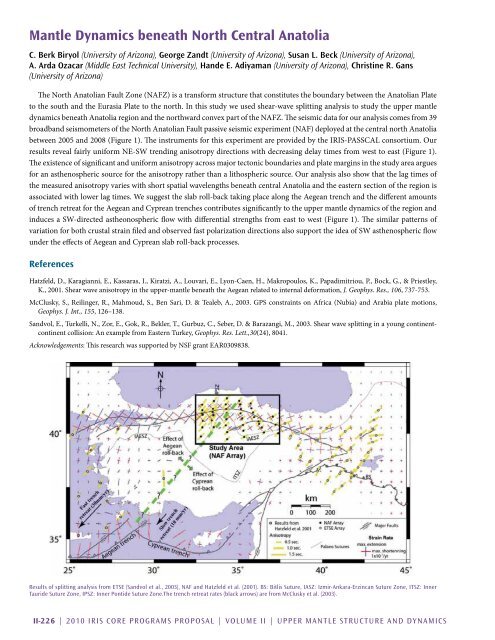Download Volume II Accomplisments (28 Mb pdf). - IRIS
Download Volume II Accomplisments (28 Mb pdf). - IRIS
Download Volume II Accomplisments (28 Mb pdf). - IRIS
You also want an ePaper? Increase the reach of your titles
YUMPU automatically turns print PDFs into web optimized ePapers that Google loves.
Mantle Dynamics beneath North Central Anatolia<br />
C. Berk Biryol (University of Arizona), George Zandt (University of Arizona), Susan L. Beck (University of Arizona),<br />
A. Arda Ozacar (Middle East Technical University), Hande E. Adiyaman (University of Arizona), Christine R. Gans<br />
(University of Arizona)<br />
The North Anatolian Fault Zone (NAFZ) is a transform structure that constitutes the boundary between the Anatolian Plate<br />
to the south and the Eurasia Plate to the north. In this study we used shear-wave splitting analysis to study the upper mantle<br />
dynamics beneath Anatolia region and the northward convex part of the NAFZ. The seismic data for our analysis comes from 39<br />
broadband seismometers of the North Anatolian Fault passive seismic experiment (NAF) deployed at the central north Anatolia<br />
between 2005 and 2008 (Figure 1). The instruments for this experiment are provided by the <strong>IRIS</strong>-PASSCAL consortium. Our<br />
results reveal fairly uniform NE-SW trending anisotropy directions with decreasing delay times from west to east (Figure 1).<br />
The existence of significant and uniform anisotropy across major tectonic boundaries and plate margins in the study area argues<br />
for an asthenospheric source for the anisotropy rather than a lithospheric source. Our analysis also show that the lag times of<br />
the measured anisotropy varies with short spatial wavelengths beneath central Anatolia and the eastern section of the region is<br />
associated with lower lag times. We suggest the slab roll-back taking place along the Aegean trench and the different amounts<br />
of trench retreat for the Aegean and Cyprean trenches contributes significantly to the upper mantle dynamics of the region and<br />
induces a SW-directed astheonospheric flow with differential strengths from east to west (Figure 1). The similar patterns of<br />
variation for both crustal strain filed and observed fast polarization directions also support the idea of SW asthenospheric flow<br />
under the effects of Aegean and Cyprean slab roll-back processes.<br />
References<br />
Hatzfeld, D., Karagianni, E., Kassaras, I., Kiratzi, A., Louvari, E., Lyon-Caen, H., Makropoulos, K., Papadimitriou, P., Bock, G., & Priestley,<br />
K., 2001. Shear wave anisotropy in the upper-mantle beneath the Aegean related to internal deformation, J. Geophys. Res., 106, 737-753.<br />
McClusky, S., Reilinger, R., Mahmoud, S., Ben Sari, D. & Tealeb, A., 2003. GPS constraints on Africa (Nubia) and Arabia plate motions,<br />
Geophys. J. Int., 155, 126–138.<br />
Sandvol, E., Turkelli, N., Zor, E., Gok, R., Bekler, T., Gurbuz, C., Seber, D. & Barazangi, M., 2003. Shear wave splitting in a young continentcontinent<br />
collision: An example from Eastern Turkey, Geophys. Res. Lett.,30(24), 8041.<br />
Acknowledgements: This research was supported by NSF grant EAR0309838.<br />
Results of splitting analysis from ETSE (Sandvol et al., 2003), NAF and Hatzfeld et al. (2001). BS: Bitlis Suture, IASZ: Izmir-Ankara-Erzincan Suture Zone, ITSZ: Inner<br />
Tauride Suture Zone, IPSZ: Inner Pontide Suture Zone.The trench retreat rates (black arrows) are from McClusky et al. (2003).<br />
<strong>II</strong>-226 | 2010 <strong>IRIS</strong> Core Programs Proposal | <strong>Volume</strong> <strong>II</strong> | Upper Mantle Structure and Dynamics
















